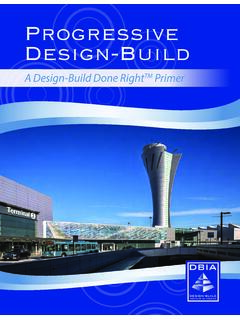Transcription of HIERARCHICAL VS. DISTRIBUTED LEADERSHIP
1 83 CHAPTER 15: HIERARCHICAL vs. DISTRIBUTED Leadership15 CHAPTERHIERARCHICAL VS. DISTRIBUTED LEADERSHIPI ntroductionFor those embarking on their Lean construction journey, it is important to understand that team culture and team cohesion on Lean/IPD projects are very different from what is commonly found on traditional projects. Therefore, choosing the right type of LEADERSHIP structure for the collaborative environment is key. According to William Seed in his paper titled Integrated Project Delivery Requires a New Project Manager, The transformational change required for [Lean/IPD] calls for project leaders who possess group facilitation skills, management skills, organizational skills, people assessment and change management skills, along with the tactical skills of the This type of leader requires a new type of organizational LEADERSHIP the group lacks experience or skills and needs guidance from superiors, a HIERARCHICAL organization structure works best.
2 When the group has the expertise to get the job done, a non- HIERARCHICAL structure with decentralized authority works Design and Construction: A Framework for WhyLeadership is an essential requirement for initiating change, developing cohesive teams and creating high-performing teams that deliver results. As more companies and projects are trying different approaches to increase productivity, engage workers, foster innovation and improve team dynamics, new LEADERSHIP approaches are emerging. Team building and power sharing are resulting in traditional HIERARCHICAL LEADERSHIP structures being replaced by more collaborative and inclusive LEADERSHIP structures, commonly referred to as DISTRIBUTED LEADERSHIP structures. Within this DISTRIBUTED LEADERSHIP structure, a new style of LEADERSHIP is developing. In addition to the skills highlighted by Seed, these new leaders are also required to share in LEADERSHIP responsibilities and act as collaborative leaders.
3 Since Lean/IPD is built around teams, these teams comprised of members from various different companies must be organized, managed and motivated properly to create High Performing HowIntegrated projects establish a network of small teams of multi-disciplinary experts to work together to optimize problem solutions. These focused teams report needs and progress to the project team and work with other focus teams to share and understand impacts of their decisions during a structured and repeating Big Room meeting process. When the work progresses to the field, the Last Planners become empowered to work together to solve problems as they arise. Open transparent information flow is critical to the success of this empowerment. This type of DISTRIBUTED LEADERSHIP structure enables groups to focus on specific tasks and allows specialists performing the work to have a high degree of autonomy and sense of empowerment.
4 LEADERSHIP is often shared among those involved based upon expertise in the current focus area and situation. Decisions are usually made on a consensus basis versus a single decision maker in a command and control HIERARCHICAL position. WhatTraditional construction projects are managed in a HIERARCHICAL structure. The term HIERARCHICAL is defined as the classification of a group of people according to ability or to economic, social or professional standing, or a graded or ranked series. 2 Group success requires matching the LEADERSHIP approach to the maturity and capability of the group members and the type of tasks being delivered. 85 CHAPTER 15: HIERARCHICAL vs. DISTRIBUTED LeadershipWhen the group lacks experience or skills and needs guidance from superiors, a HIERARCHICAL organization structure works best. When the group has the expertise to get the job done, a non- HIERARCHICAL structure with decentralized authority works best.
5 Given that ILPD teams depend upon the strong expertise of each member involved, are often self-selected through the Choosing by Advantages process, and are chosen based on best value, the best way to leverage the breadth of skills of the ILPD team is through a DISTRIBUTED LEADERSHIP approach. According to the Collaborative Lead Training Company in a 2012 article titled 8 Differences between Traditional and Collaborative Leaders, 3 the following eight characteristics exemplify collaborative leaders: Believe power is greatest in a collective team Openly share information and knowledge Encourage suggestions and ideas from their team Facilitate brainstorming with their teamIn DISTRIBUTED LEADERSHIP , groups let go of traditional command-and-control Design and Construction: A Framework for Change86 Enable their team with immediate time and resources Allow roles and responsibilities to evolve and fluctuate Seek to uncover root causes of issues Offer immediate and ongoing feedback with personalized coachingBy employing the appropriate LEADERSHIP approach, project leaders can enable the project team to develop more innovative ways to achieve widespread optimization and better project results overall.
6 DISTRIBUTED LEADERSHIP fosters 1) better innovation on projects because ideas can come from multiple inputs rather than just the labeled experts in the room and 2) better knowledge distribution so the project team can still remain high performing even if people come and go. Recommendations for maximizing the success of DISTRIBUTED LEADERSHIP includes: A willingness to let go of traditional command-and-control behaviors An inclination and ability to solicit information from others with different perspectives Humbleness and a spirit of continuous learning Decisions need to have buy-in for them to be effectiveReferences1. Integrated Project Delivery Requires a New Project Manager ; Seed, (2014); International Group for Lean Construction, Proc. 22nd Annual Conference, Oslo, Norway, June 25-27. pp 1447-14592. Merriam-Webster Dictionary, Collaborative Lead Training Company, The LEADERSHIP Challenge , Fifth Edition, James Kouzes and Barry Posner, 2012 Leaderful Concept ; Railin, J.
7 (2015); The Leaderful Institute website, Boston, MA, Preparing for Leaderful Practice ; Raelin, J. (2004); T+D, 58(3), March issue87 CHAPTER 15: HIERARCHICAL vs. DISTRIBUTED LeadershipQuick ReferenceHigh-Performing Teams ..113 Last Planner System ..147 The Big Room ..209 HIERARCHICAL VS. DISTRIBUTED LEADERSHIPFor additional readings and information, pleasesee the below 15 HIERARCHICAL VS. DISTRIBUTED LEADERSHIP Additional Readings Barrett-Self-Organization and Synchronization at the Edge Implementing Edge Psychological foundations for incentives





